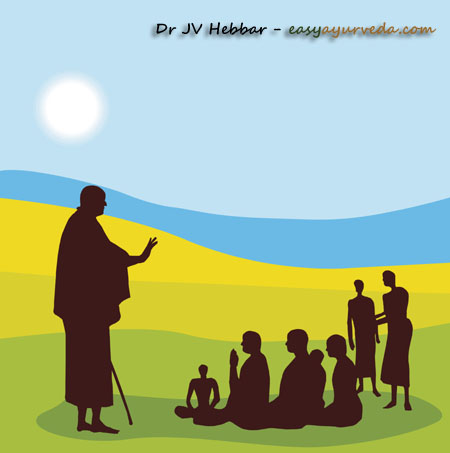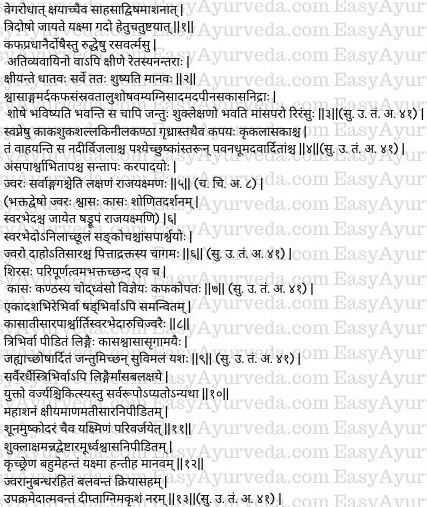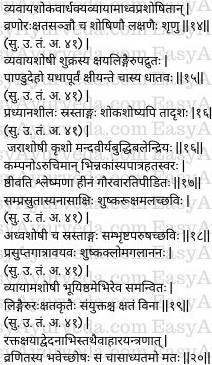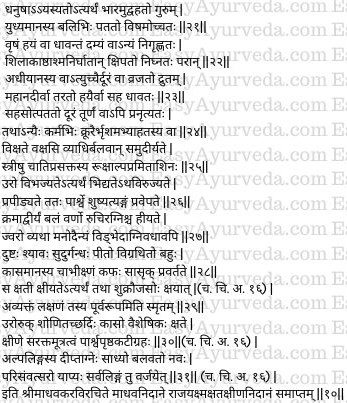Madhava Nidana Chapter 10 Rajayakshma Kshatakshina Nidanam
This article explains Madava nidaana 9th chapter “Rajayakshma Nidanam”. Causes, pathology and symptoms of Rajayakshma are explained in this chapter.
Read – Acharya Madhavakara: His Work ‘Madhava Nidana’, Legacy, Amazing Facts

Table of Contents
Causes
4 main causes of Rajayakshma
Yakşmā is a disease caused by all the three doshas together. Below mentioned are the four important factors which would produce yakşmā.
- Suppression of natural urges
- Loss or deficiency of tissues
- Over-exertion and
- Indulgence in unhealthy foods (1)
Read – Rajayakshma Chikitsa – Charaka Chikitsa 8
Samprapti
Pathogenesis of yaksma
There are two pathways in which yaksma develops
- When the rasavaha srotas become obstructed by the tridoshas among which kapha is predominant or
- In persons who indulge in excessive sexual intercourse leading to the loss of semen
When these events occur, they cause deficiency of all the other dhātus – tissues of the body making the person too emaciated. Such a disease is called yaksma or rajayaksma. (2)
Read – Decrease Of Tissues – Dhatu Kshaya – Reasoning, Symptoms

Purvarupa
Premonitory symptoms of Rajayaksma
The premonitory symptoms of rajayaksma include – dyspnoea (breathlessness, increased / difficult respiration), pain in the body, expectoration of sputum, dryness of the palate, vomiting, poor digestion, intoxication, running nose, cough, excessive sleep, eyes becoming bright white; person craves for meat and sexual intercourse. In his dreams he sees himself being carried away by the crow, parrot, porcupine, peacock vultures, monkey and chameleon, sees rivers without water, trees without leaves, breeze, smoke and forest fires. (3-4)
Symptoms of Rajayaksma
Lakshana
Discomfort (pain) in the scapular region (shoulders) and flanks, feeling of warmth (mild burning sensation) in the hands and feet, fever all over the body are the symptoms of rājavaksmā.(5)
(According to other opinions – aversion to food, fever, dyspnoea or increased / difficult respiration, cough appearance of blood in the sputum and hoarseness of voice are the six symptoms of rajayakshma.)
11 symptoms
Ekadasha Lakshanas
Symptoms caused by Vata predominance are 3 in number – Hoarseness of voice, pain in the shoulders, constriction (deformity) of shoulders and flanks.
Symptoms caused by Pitta predominance are 4 in number – Fever, burning sensation, diarrhoea and blood in the sputum (haemoptysis).
Symptoms caused by Kapha predominance are 4 in number – Feeling of fullness of the head, aversion to food, cough and irritation in the throat.
These are the (eleven) important symptoms of Rajayaksma. (6-7)
Read – Charaka Kshatasheena Chikitsa 11th chapter
6 symptoms, 3 symptoms, Prognosis
Presence of all the eleven symptoms (enumerated above) or the six symptoms viz., cough diarrhoea, pain in the flanks, hoarseness of voice, anorexia and fever or even the three symptoms viz., cough, dyspnoea (increased / difficult respiration and appearance of blood in the sputum – calls for refusal of such patients by physicians desiring a good reputation.
This means to say that in the presence of all these symptoms together will indicate bad prognosis and hence the doctor can deny treating such conditions by the physicians who want to keep away from getting a bad name and reputation.
Appearance of all the symptoms (11 symptoms), or half of it (six – approximately half of eleven) or of even three, in persons who have loss of muscles (wasting of muscles) and strength are also indications of bad prognosis and hence should be refused by a wise physician.
Patients of yaksmā who eat large quantities of food but still undergo wasting; who are having diarrhoea, swelling of the scrotum and abdomen are also to be avoided (denied treatment).
Yaksma kills such persons who have whiteness of eyes, aversion to food, heavy and troublesome expirations and who eliminate large quantities of urine with difficulty. (8-12)
Conditions for treating the patients of Rajayaksma
Treatment can be given to patients of yakşmā who do not have fever, who are strong, able to withstand the discomforts of treatments, of strong will, good (strong) digestive capacity and who are not emaciated.(13)
Types of Shosha
Shosha (consumption, wasting, emaciation) is of 7 types. They are caused due to –
- sexual intercourse
- grief
- old age
- physical exertion,
- walking long distances,
- ulcers and
- injury to the chest
Henceforth the symptoms of the persons afflicted with above mentioned types of shoshas are described. (14)
Read – Tissue Depletion (Shosha) Meaning, Types, Symptoms
Vyavaya Shosha Lakshanas
Vyavaya Shosha Lakshanas – Symptoms of wasting caused due to excessive indulgence in sexual intercourse
In persons who indulge in excessive sexual intercourse, symptoms of deficiency of semen and yellowish white discolouration of the body (pallor) and subsequent wasting of the other tissues of the body are seen. (15)
Shoka Shosha, Jara Shosha Lakshanas
Symptoms of wasting caused due to grief & ageing
In people whose body is wasted due to excessive grief, too much of worry, looseness and weakness of the body are seen.

The symptoms of persons wasted due to senility (old age) include – emaciation, decrease of vigour, intellect, strength and capacity of sense organs; shaking of the body parts and anorexia. The voice of such a person would be husky, feeble and broken as that of a piece of broken bronze vessel. The patient tries hard to expectorate but brings out little sputum or no sputum. The other symptoms are heaviness of the body, restlessness, fluid oozing out of mouth, nose and eyes, loss of complexion and dryness (of faeces).(16-17)
Read – Rasayana Therapy (Anti Ageing, Rejuvenation) Benefits, Meaning, Medicines
Adhwa Shosha Lakshanas
Symptoms of wasting due to constant long-distance walking
Persons wasted due to constant long-distance walking will be having weakness, hardness and loss of sensation of body parts, dryness of klomā, throat and mouth. (18)
Note – Kloma is an organ whose description has not been detailed in Ayurveda texts. As per this context and kloma being one of the roots of ‘water transporting channels’ in the body, it can be considered as pharynx or palate (roof of the inside of the mouth).
Read – Understanding Kloma And Its Different Meanings With Contexts
Vyayama Shosha
Symptoms of wasting caused due to excessive physical exertion
Persons wasted due to excess physical exertion will also have the same symptoms as above and symptoms of injury to the chest without of course an actual tear. (19)
Vrana Shosha
Symptoms of wasting caused due to ulcer / wound
Wasting due to ulcer is caused by loss of blood, pain and control over food by the person. This condition is difficult to treat.(20)
Read – Charaka Vrana Chikitsa – 25th Chapter – Wounds, Ulcers
Urah Kshata – Nidana, Lakshanas
Causes and symptoms of ‘chest injury’
Chest injury (tear inside the lungs) is caused due to one or more of – excessive indulgence in archery, carrying heavy loads on the head, combating / wrestling with strong persons, falling from a height recklessly, forcibly trying to stop a mighty bull or horse which is running, or taming wild animals, throwing heavy stones, wooden rafters or catapults, fighting with enemies (using weapons),reading loudly with high pitch, running fast for long distances, swimming mighty rivers, running along with horses, sudden jumping, strenuous dancing and such other acts of violence and excessive sexual intercourse, partaking of dry, scanty and non-nutritious foods.
As a result, the patient will have cut or pricking pain in the chest and flanks, followed by emaciation, tremors; loss of vigour, strength, complexion, interest and digestive capacity. There also occurs the appearance of fever, grief, helplessness, diarrhoea, indigestion, cough with bad, black, fetid, yellowish pellets of sputum in large quantities coming out often mixed with blood. This condition is known as ‘uraksata’. This condition causes quick loss of sukra (semen) and ojas (essence of all the tissues) and leads to severe emaciation.(20-28)
Read – What is Ojas? How To Increase Ojas During Health And Disease?

Purvarupa
Premonitory symptoms
The very symptoms of this disease itself are seen in mild form during the premonitory period. (29)
Difference between Ksata and Ksina
Pain in the chest, vomiting of blood, cough is prominent if ksata – trauma (tear) is present. On the other hand, if only emaciation is present, urine mixed with blood, catching pain in the flanks, back and waist (hips) are predominant. (30)
Read – How To Make Prognosis Of Disease According To Ayurveda?
Prognosis
Uraksata which has mild symptoms, manifesting in strong persons, is of recent origin and occurring in whom the digestive capacity is good is curable.
Uraksata which has remained over one year (one year old), does persist throughout life, and that which has all the symptoms is incurable. (31)
Thus ends the chapter on RājayaksmāNidanam in Madhava Nidana text written by Acharya Madhavakara.











